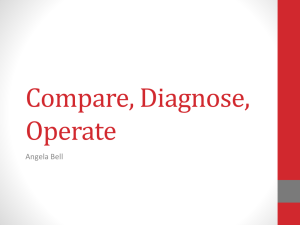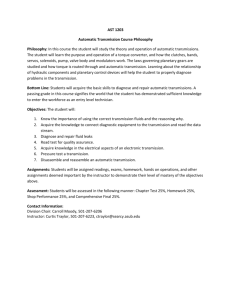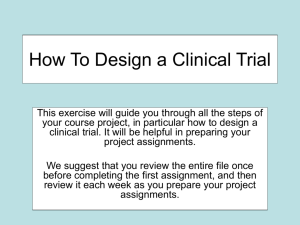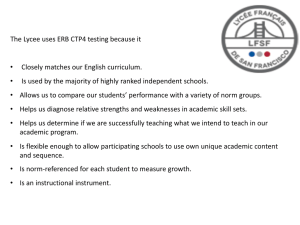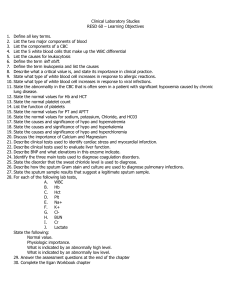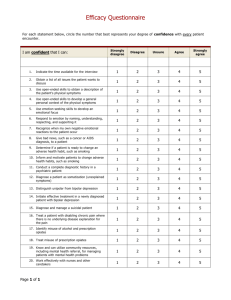Clinical Research Project
advertisement
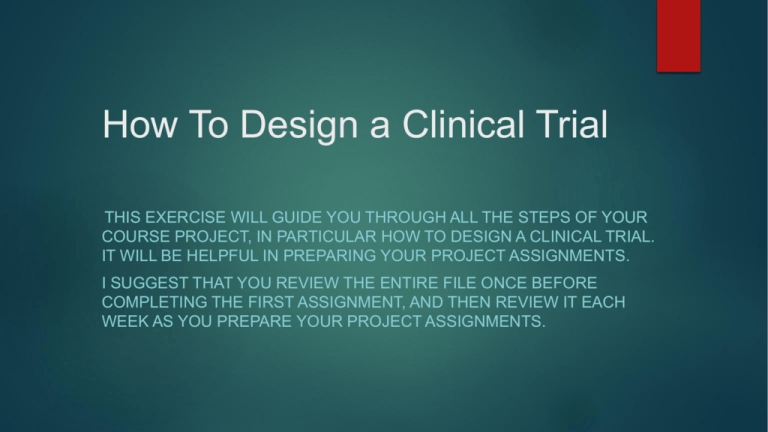
How To Design a Clinical Trial THIS EXERCISE WILL GUIDE YOU THROUGH ALL THE STEPS OF YOUR COURSE PROJECT, IN PARTICULAR HOW TO DESIGN A CLINICAL TRIAL. IT WILL BE HELPFUL IN PREPARING YOUR PROJECT ASSIGNMENTS. I SUGGEST THAT YOU REVIEW THE ENTIRE FILE ONCE BEFORE COMPLETING THE FIRST ASSIGNMENT, AND THEN REVIEW IT EACH WEEK AS YOU PREPARE YOUR PROJECT ASSIGNMENTS. Overview EXPERIMENT DESIGN & CLINICAL TRIAL DESIGN Designing an Experiment Goal: –Test a hypothesis Procedure: –Change one factor at a time (the independent variable) –Observe outcomes (the dependent variables) Example: –Compare effect of two different antibiotics on bacterial growth rate –Independent variable: type of antibiotic –Dependent variable: growth rate of bacteria –Must ensure that every variable (e.g. temperature, concentration of antibiotic, duration of experiment) remains the same except for choice of antibiotic Designing a Clinical Trial Goal: –Compare effectiveness of two different medical procedures Procedure: Two groups of patients, each receives a different medical procedure (independent variable) Observe clinical outcomes in the groups of patients (dependent variables) Primary outcome: Most clinically important outcome Secondary outcomes: Other clinical results of interest Example: Compare effectiveness of two different types of antibiotics to treat bacterial pneumonia Independent variable: Type of antibiotic Dependent variables: •Primary outcome: duration of symptoms •Secondary outcomes: severity of symptoms Must ensure that every variable (e.g. ages of patients, concentration of antibiotic, severity of initial disease) remains the same except for the choice of antibiotic Determining Sample Size What is sample size: The number of patients in the control and experimental groups How do we choose the sample size: Ideally, the only difference between the control and experimental groups is the change in the independent variable In practice, this is never true because of biological variability between subjects We want our sample size to be large enough so that any differences between the experimental and control groups can be attributed to the change in the medical procedure and not just because of patient to patient differences We want our sample size to be small enough so that we can afford to carry out the study Designing Your Clinical Trial PROJECT ASSIGNMENTS 1-9 Your Clinical Trial Goal: Propose a new drug/technology to solve a health problem Present plans for a clinical trial to evaluate the drug/technology Must identify: A disease of global health significance Current medical technologies to diagnose or treat the disease Limitations of those technologies in a resource challenged setting A new medical technology/drug to diagnose or treat the disease An appropriate clinical trial design Subjects to be tested Primary & Secondary outcomes Sample size Must submit: One page summaries of your progress A clinical trial research protocol An informed consent document A presentation of your findings & proposed solution Designing Your Clinical Trial Project Steps: Task 1:Define a public health problem Task 2:Evaluate a drug/technology to diagnose or treat this disease Task 3:Evaluate drug/technology limitations Task 4:Propose a new drug/technology Task 5: Design a clinical trial specify the standard of care and new drug/technology to be compared choose the subjects to be tested; control & experimental groups determine inclusion & exclusion criteria determine primary & secondary outcomes to monitor in the trial determine the sample size Task 6: Determine your trial outcomes Task 7: Write a Research Protocol Task 8: Write Informed Consent Document Task 9: Make Presentations Task 1. Define a public health problem Due: Thursday 12/10/15 by end of class You may select your topic from a wide range of health issues. You must simply demonstrate that the chosen issue significantly and adversely affects the lives of people in a country or region of your choice. Write a one-page (typed) summary of your disease including: Epidemiology Prevalence/incidence in the region/country of interest Risk factors Pathophysiology of the disease Physical signs and symptoms Task 2: Evaluate available drugs/technologies to diagnose/treat the selected disease Due Monday 12/14/15 by end of class y Assess the actual effectiveness of current drugs or strategies employed throughout the world to diagnose/treat the selected disease. Consider: What are the usage constraints? Are current solutions available only to a limited population due to cost or other factors? Could alternate materials or approaches be used to reduce the overall cost? Is there another strategy/design that has never been tried? Write a one-page (typed) summary of: Current methods for diagnosis and their constraints Summarize the scientific principles of these technologies Are these technologies available in the selected region? Current treatments and their constraints Summarize the scientific principles of these technologies Are these technologies available in the selected region? Task 3: Evaluate technology limitations to diagnose or treat the selected disease Due Wednesday 12/16/15 by end of class Assess the actual effectiveness of current drugs or strategies employed in the selected country or region of the world to diagnose/treat the selected disease. Consider: Of all current drugs/technologies available, which are feasible given the current resources in your selected part of the world? Are large clinical trials underway to test new solutions? What are the limitations of these approaches? Write a one-page (typed) summary of: Current methods for diagnosis available in the selected country or region The current limitations associated with the technology How does this compare to other parts of the world? Current methods for treatment available in the selected country or region The current limitations associated with the technology How does this compare to other parts of the world? Task 4: Propose a new drug/technology to diagnose/treat the selected disease Due Friday 12/18/15 by end of class Your solution should provide an advantage compared to existing options; either as an improvement to an existing drug or a totally new strategy. For example, if your project is to develop alternative TB therapies, you might propose an alternate drug delivery mechanism (e.g. patches, controlledrelease injections, implantable devices, etc) that could be used to deliver 6 to 9 months of TB therapy. Turn in a one page summary of your new solution, including: an overview of your drug/device design the scientific principles of the drug/design the expected benefits of the drug/design the potential risks associated with the drug/design Task 5. Choose Subjects to be Tested Due Tuesday 12/22/15 by end of class Consider how you will test the drug/technology in your trial: What will the control group receive? What is the standard of care? What will the experimental group receive? Will it be the new technology alone or the standard of care plus the new technology? Why? Who would be ideal subjects for a study involving your disease and your new drug/technology? In choosing the ideal subjects, consider the potential risks and benefits of your technology. Remember that you want a study design with a favorable benefit/risk ratio What will be the inclusion/exclusion criteria for your study? Which patients will serve as the control group and which will serve as the treatment group? Turn in a design for a clinical trial. Specify the following: the diagnostic/treatment standard of care and new drug/technology to be compared the experimental group and control group participant inclusion and exclusion criteria Task 6. Determine Trial Outcomes Due 1/4/16 by end of class Consider the outcomes of your trial. What will be the primary outcome monitored in your clinical trial? What will be the secondary outcomes monitored in your trial? What should be the expected values for the primary outcome in the control and experimental groups (quantitative answer)? What should be the expected difference in the primary outcome between the control and treatment groups (quantitative answer)? Turn in a design for a clinical trial. Specify the following: the primary outcome of interest, and its expected values for and between your control and experimental groups the secondary outcomes of interest, and their expected values for your control and experimental groups Task 7. Write Research Protocol Due 1/8/16 by end of class Write a research proposal to test your drug/technology, specifying: title of the research trial name of the principal investigator(s) background, hypothesis, research questions, and project goals research methods, design, and proposed statistical data analysis human subject interactions; including source for participants, procedures for recruitment, and procedures for obtaining informed consent potential risks and benefits to participants sites or agencies involved in the research Task 8. Write Informed Consent Document Due on 1/11/16 by end of class Write a consent form for a protocol testing your drug/technology, specifying: the purpose of the study, the research procedure, risks and anticipated benefits to research participants, alternative procedures available to diagnose/treat the health condition, contact information for the principle investigator and the institutional review board, the research participant’s right to withdraw from the study at any time Task 9. Make a PowerPoint Presentation of your Clinical Trial Due on 1/15/16 by end of class Please Include Slides on the following: Slide 1:Define a public health problem Slide 2:Evaluate a drug/technology to diagnose or treat this disease Slide 3:Evaluate drug/technology limitations Slide 4:Propose a new drug/technology Slide 5 - 9: Design a clinical trial specify the standard of care and new drug/technology to be compared choose the subjects to be tested; control & experimental groups determine inclusion & exclusion criteria determine primary & secondary outcomes to monitor in the trial determine the sample size Slide 10: Determine your trial outcomes Task 11: Write a Research Protocol Task 12: Write Informed Consent Document
